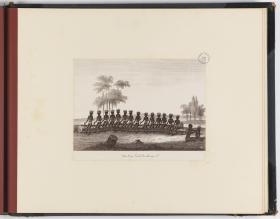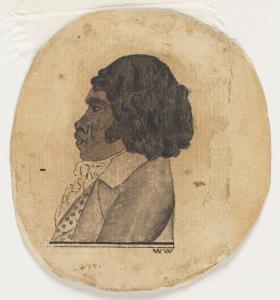Fighting back
Students examine the experiences of Aboriginal people in the early colony and their interactions with the First Fleet colonists in the context of disease, conflict, war and resistance.
Key inquiry question #1
Why did Europeans settle in Australia?
Key inquiry question #2
What was the nature and consequence of contact between Aboriginal and/or Torres Strait Islander peoples and early traders, explorers and settlers?
Learning intention
Students are learning to:
- recognise the threats to survival of Aboriginal people in the early colony
- examine and question sources of information
Success criteria
Students will be successful when they can:
- determine the impact of European settlement on Aboriginal people
- explain the issues around war and resistance for Aboriginal people
Student Activities
Smallpox outbreak
Students learn about the smallpox outbreak and its devastating impact on Aboriginal people.

Abduction
Students explore the events in the changing relationship between Arthur Phillip and Aboriginal people.

War and resistance
Students examine the events leading to Pemulwuy’s role in the war against the colonists.

NSW Syllabus for the Australian Curriculum History K-10
A student:
- HT2-3 describes people, events and actions related to world exploration and its effects
- HT2-4 describes and explains effects of British colonisation in Australia
- HT2-5 applies skills of historical inquiry and communication
Stories of the First Fleet, including reasons for the journey, who travelled to Australia, and their experiences following arrival (ACHHK079)
Students:
- describe the establishment of the British colony at Port Jackson
- using a range of sources, investigate the everyday life of ONE of the following who sailed on the First Fleet and lived in the early colony: a soldier, convict, ex-convict, official
The nature of contact between Aboriginal people and/or Torres Strait Islanders and others, for example, the Macassans and the Europeans, and the effects of these interactions on, for example, families and the environment (ACHHK080)
Students:
- describe the nature of contact between Aboriginal people and/or Torres Strait Islander peoples and others, including Aboriginal resistance
- use sources to identify different perspectives on the arrival of the British to Australia
- outline the impact of early British colonisation on Aboriginal and Torres Strait Islander peoples' country.
Comprehension: chronology, terms and concepts:
- respond, read and write, to show understanding of historical matters
- sequence familiar people and events
- use historical terms
Analysis and use of sources:
- locate relevant information from sources provided
Perspectives and interpretations:
- identify different points of view within an historical context
Empathetic understanding:
- explain how and why people in the past may have lived and behaved differently from today
Research:
- pose a range of questions about the past
- plan an historical inquiry
Explanation and communication:
- develop texts, particularly narratives
- use a range of communication forms (oral, graphic, written) and digital technologies
Continuity and change: changes and continuities due to British colonisation of Australia.
Cause and effect: reasons for a particular historical development
Perspectives: different points of view within an historical context
Empathetic understanding: how and why people in the past may have lived and behaved differently from today.
Significance: the importance and meaning of national commemorations and celebrations, and the importance of a person or event.
Contestability: historical events or issues may be interpreted differently by historians, eg British 'invasion' or 'settlement' of Australia.
Cross-curriculum priorities:
- Aboriginal and Torres Strait Islander histories and cultures
General capabilities:
- Critical and creative thinking
- Ethical understanding
- Intercultural understanding
- Literacy
Stories of the First Fleet, including reasons for the journey, who travelled to Australia, and their experiences following arrival (ACHASSK085)
- investigating attitudes to the poor, the treatment of prisoners at that time, and the social standing of those who travelled to Australia on the First Fleet, including families, children and convict guards
- investigating daily life in the Botany Bay penal settlement and challenges experienced by the people there and how they were managed.
The nature of contact between Aboriginal and Torres Strait Islander Peoples and others, for example, the Macassans and the Europeans, and the effects of these interactions on, for example, people and environments (ACHASSK086)
- exploring the impact that British colonisation had on the lives of Aboriginal and Torres Strait Islander Peoples (dispossession; dislocation; and the loss of lives through conflict, disease, loss of food sources and medicines)
- considering whether the interactions between Europeans and Aboriginal and Torres Strait Islander Peoples had positive or negative effects
- examining paintings and accounts (by observers such as Watkin Tench and David Collins) to determine the impact of early British colonisation on Aboriginal Peoples' Country
Additional Information
The following information supports the above activities. Read the activities first.
Activity 2 Answers
Q: What type of clothes is Bennelong wearing?
A: The clothes are British clothes. You can see a shirt, a ruffled neckerchief (scarf or cravat) and a spotted waistcoat under his frock coat.
Q: Where do you think he might be?
A: Historians think the drawing was completed in 1793 when he was in England.
Source list for image details in student activity
Image 1: 118. Yoo-long Erah-ba-diang 1-8 / (Collins), J. Neagle sculpt., ca. 1880-1889 (copy photoprints of earlier works, 1770+)
Image 1: William Bradley, Opp. p. 182. `Taking of Colbee & Benalon. 25 Novr 1789', ca. 1802
Image 2: Michael Sedunary, The Unlikely Story of Bennelong and Phillip, Berbay Publishing, 2015
Image 1 & 2: James Grant, The narrative of a voyage of discovery : performed in His Majesty's vessel the Lady Nelson, of sixty tons burthen, with sliding keels, in the years 1800, 1801 and 1802, to New South Wales / by James Grant ... to which is prefixed, an account of the origin of sliding keels ... [Album view], 1803